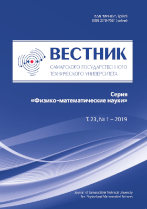|
Mathematical Modeling, Numerical Methods and Software Complexes
Mathematical modeling of mass transfer in electromembrane systems in galvanodynamic mode, taking into account electroconvection and the dissociation/recombination reaction of water molecules
A. Ì. Uzdenova
Umar Aliev Karachai-Cherkess State University,
Karachayevsk, 369202, Russian Federation
(published under the terms of the Creative Commons Attribution 4.0 International License)
Abstract:
Mass transfer in electrodialysis systems during intense current modes is accompanied by the emergence of additional transfer mechanisms that significantly affect their operational efficiency. According to modern concepts, for dilute electrolyte solutions, mechanisms such as electroconvection and the dissociation/recombination reactions of water molecules are particularly important. These processes have opposing effects on the effectiveness of electrodialysis technologies.
Mathematical models that take these mechanisms into account are actively used in membrane system research; however, they typically describe only the potentiostatic regime, in which a potential jump is established in the system. The interpretation of a vast database of experimental data for the galvanodynamic regime (at fixed current density) also requires theoretical analysis tools.
The aim of this work is to develop a mathematical model of mass transfer in the electrolyte solution layer at an ion-exchange membrane, considering electroconvection and water dissociation in the galvanodynamic regime. The model is based on a system of coupled Nernst–Planck–Poisson–Navier–Stokes equations, supplemented by a new galvanodynamic boundary condition for the potential.
Using the developed model, chronopotentiograms of the membrane system were calculated for the first time, taking into account the influence of both electroconvection and the dissociation/recombination reactions of water molecules. The results showed that the ratio of the concentration of water dissociation products to the concentration of salt ions determines the balance of the effects of electroconvection and dissociation.
The following options for balancing the effects of electroconvection and dissociation of water molecules are considered:
1) electroconvection significantly influences mass transfer, while the influence of water dissociation is minimal;
2) electroconvection and dissociation substantially affect transport processes: the formation of additional charge carriers from the dissociation of water molecules reduces the potential jump in the electrolyte layer, which decreases the intensity of electroconvection, while the development of electroconvection, in turn, slows down the dissociation process;
3) the products of intense water dissociation slow down the development of electroconvection.
Keywords:
electromembrane system, ion transport, electroconvection, dissociation/recombination reaction of water molecules, galvanodynamic mode, Nernst–Planck–Poisson–Navier–Stokes equations
Received: March 3, 2024
Revised: April 29, 2024
Accepted: June 4, 2024
First online: September 23, 2024
Citation:
A. Ì. Uzdenova, “Mathematical modeling of mass transfer in electromembrane systems in galvanodynamic mode, taking into account electroconvection and the dissociation/recombination reaction of water molecules”, Vestn. Samar. Gos. Tekhn. Univ., Ser. Fiz.-Mat. Nauki [J. Samara State Tech. Univ., Ser. Phys. Math. Sci.], 28:2 (2024), 324–344
Linking options:
https://www.mathnet.ru/eng/vsgtu2086 https://www.mathnet.ru/eng/vsgtu/v228/i2/p324
|

| Statistics & downloads: |
| Abstract page: | 198 | | Full-text PDF : | 38 | | References: | 26 |
|




 Contact us:
Contact us: Terms of Use
Terms of Use
 Registration to the website
Registration to the website Logotypes
Logotypes









 Citation in format
Citation in format 